Coffee in Italy is much more than just a pick-me-up first thing in the morning. It’s a ritual, a routine, and a pause in an otherwise busy day. Italians love coffee, but if you’ve never traveled to Italy, you may be surprised to learn that Italians don’t drink coffee like Americans.
Instead, they drink small shots of espresso (correctly pronounced “ess-press-oh,” without an “x”), sometimes many times throughout the day. Espresso contains less caffeine than American coffee and the average Italian drinks four shots of espresso daily! But it’s not unheard of to drink even more.
If you’ve been curious about how coffee in Italy became such an integral part of the Italian culture or what to order on your next trip, read on for our best insider tips about coffee in Italy.
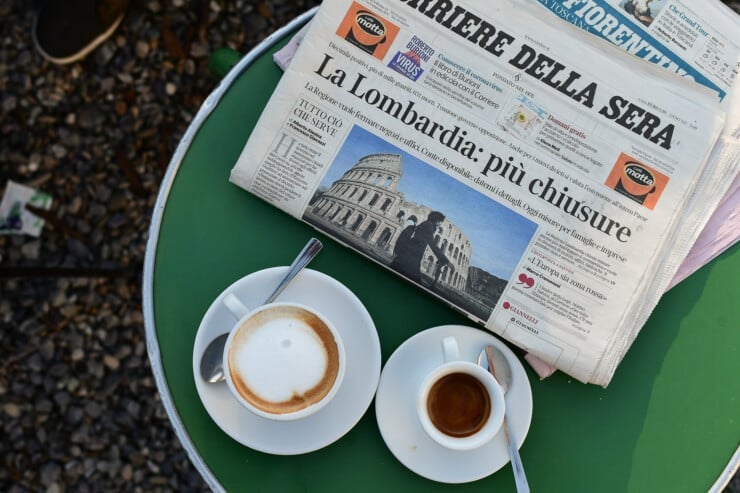
The History of Coffee in Italy
Drinking coffee all hours of the day was not always the norm in Italy, although it has been popular for nearly 500 years. In fact, we know the precise date and location where coffee stole the heart of Italians: 1570 in Venice when an Italian named Prospero Alpino introduced it to Venetians after his travels in the far east.
At first, coffee in Italy was considered medicinal and sold only in pharmacies. However, thanks to its certain appeal of seeming semi-forbidden (it was called the “bitter invention of Satan” by Pope Clement VIII), wealthy Venetians started to drink this “elixir” more and more. Thankfully, after trying it, Pope Clement VIII changed his stance, and by 1645, coffee had made its way down to Rome.
By 1763, only two hundred years after the introduction of coffee in Italy, there were 218 coffee bars in Venice alone. This might not sound like a lot today, but it means there was a coffee shop or “bar,” as Italians still call them, on nearly every street corner. Almost every Venetian at that time, from rich to poor, was taking part in a daily espresso.
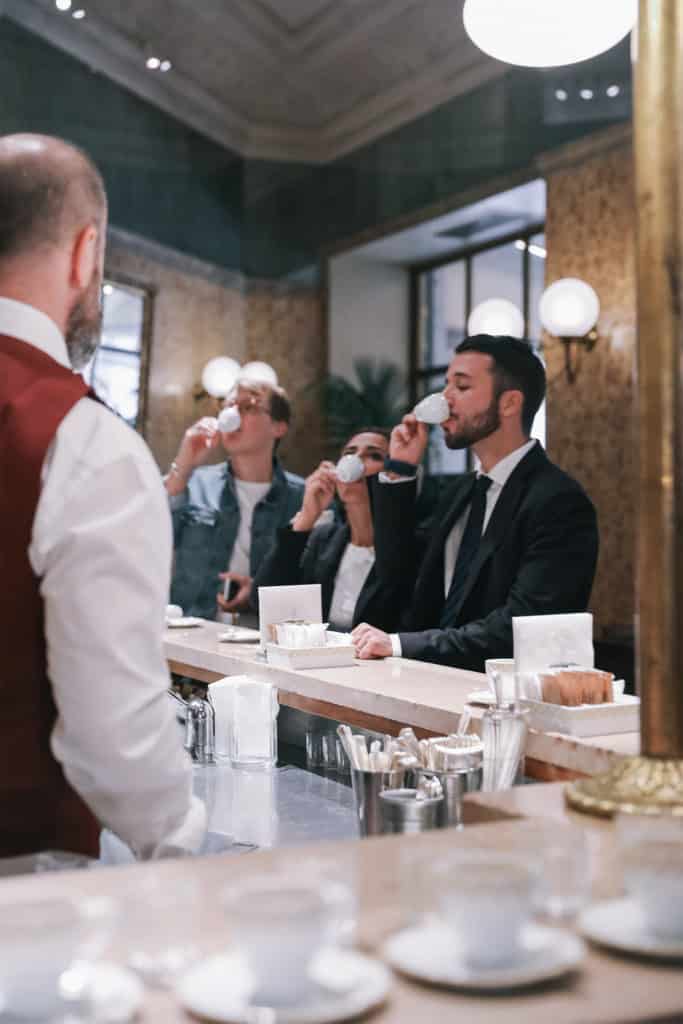
9 Tips About Italian Coffee Culture
Over nine million cups of espresso are served daily in Italia, and the love of coffee in Italy is not going away anytime soon. So, if you’re planning to visit Italy and are a coffee drinker, you should know a few things.
The first is how to order a coffee in Italy: ask for “un caffè” not for espresso, as that’s a technical term. Espresso, made by forcing steam through finely ground coffee beans, is the base for all coffee drinks in Italy. Ordering a “caffe” will get you precisely one shot of espresso – no frills included.
If you want a coffee resembling the drip coffee you may drink back home, ask for a “caffè Americano” or an American coffee. However, be warned; it’s not like an American drip coffee. Instead, it’s a shot of espresso mixed with hot water. You can find American drip or pour-over coffee in Italy, but it’s more likely in major cities’ modern specialty coffee bars.
Italian coffee culture also has some etiquette to follow. Italians know these unspoken norms and the tourist plays catch-up upon arrival. If you want to fit in, it’s worth knowing a few of these to avoid a faux pas.
Don’t Drink A Cappuccino After Noon
Just say “no” to drinking a cappuccino after meals or in the afternoon. A cappuccino is considered a breakfast drink. For Italians, it’s a heavier beverage and is believed to impede digestion if consumed later in the day. Italians generally think it’s odd to order a cappuccino after a big meal for the same reason. So, remember to stick to non-milk-based drinks after lunchtime or after you eat.
However, if you need milk in your coffee but don’t want to make a cultural blunder, order a “caffe macchiato” with just a touch of milk foam (no milk mixed into the base), so it’s an acceptable form of coffee any time of day.
It’s A Coffee Bar, Not A Coffee Shop
Another rule, or norm for coffee in Italy, is that coffee is served at a “bar.” You can get coffee nearly everywhere in Italy (even in the waiting room at some post offices!), but it’s never called a coffee shop. So, if you’re looking for coffee, ask for the nearest bar. (And if you’re looking for a beer, ask for a pub!)
Italians Often Drink Coffee Standing Up
Sitting down and slowly sipping their drinks from a small cup, or even more so, ordering it to go, is not the norm. That’s not to say it doesn’t happen, but it’s more common to see Italians taking a quick coffee standing up at the bar. If you prefer to drink your coffee sitting down, consider that many bars charge extra for table service. You might see a price listed as around 1 euro for a coffee at the bar, but suddenly, it becomes 3, 4, or even 5 euros while you sit at a table. Not all places do this; some offer free seating, but it’s something to remember before grabbing a chair.
Water Is Not Served For Free
Last rule: Water is not served for free in Italy, except at some coffee bars. For example, you might find that your espresso is served with a small glass of water in Naples. This is normal, and depending on who you ask, it’s for drinking before or after you’ve finished your coffee to clean your palette.
A Mocha Doesn’t Exist
If you’re used to ordering a “mocha” at your home coffee shop, you may wonder how to order a similar coffee in Italy. Unfortunately, there isn’t an exact Italian equivalent. However, some drinks are similar, and I would argue that the Italian versions are even tastier, as they are richer, smaller (so they don’t make you feel full), and generally have less sugar.
A couple of great options to replace your American “mocha” are the marocchino and the mocaccino, which we detail below.
Also, a note for those of you “mocha” lovers: Be sure not to ask for a mocha in Italy. The word mocha has the same pronunciation as the Italian Moka pot, which is essentially an at-home stove-top espresso brewing device. If you ask for a “mocha,” they will assume you want this type of home-brewed espresso, and they may turn you away entirely as they aren’t often used at bars or restaurants.
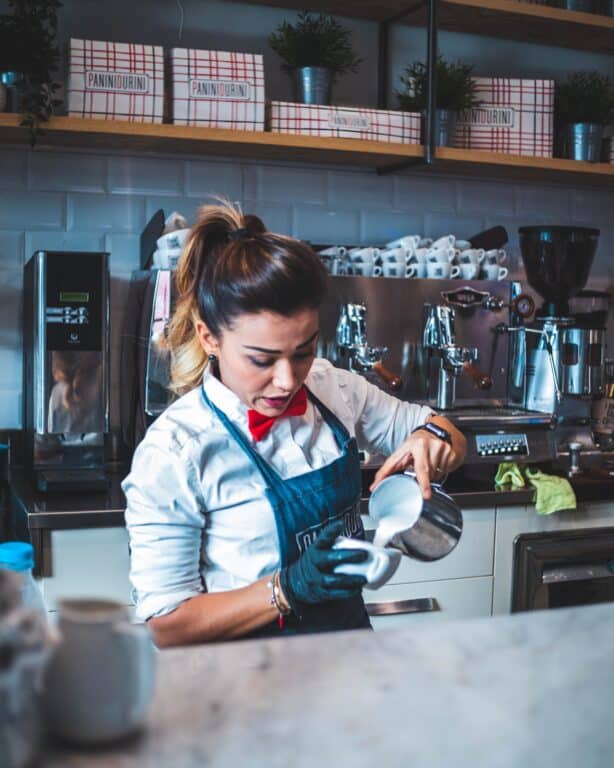
How To Order Coffee In Italy
Ordering a coffee in Italy is generally pretty straightforward, with one thing to remember. Unless the barista knows you, paying first is customary if you plan to take your coffee standing.
After paying and ordering, you will take your “scontrino” or receipt to the barman at the counter and reiterate your order. They will rip it or put a mark across the receipt (to show that they’ve fulfilled the order), give it back, and get to work preparing.
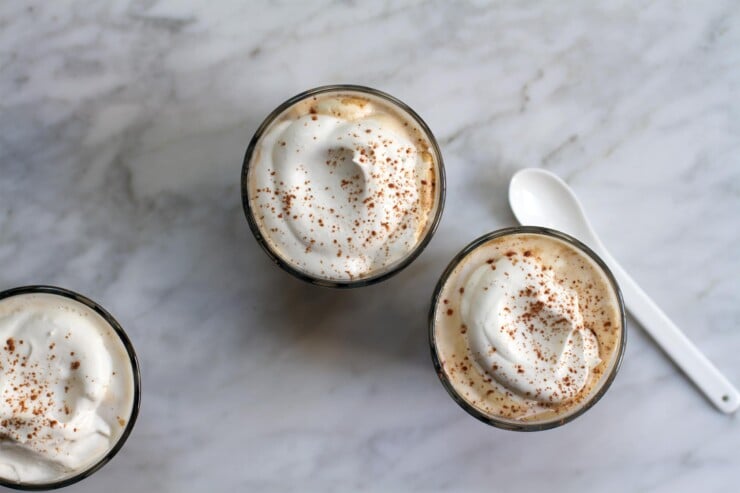
15 Classic Types Of Coffee In Italy
If you’re still unsure what to order when it comes to coffee in Italy (you likely won’t find a list with descriptions on it), here are some popular coffee drinks worth remembering:
Cappuccino (cah-poo-chee-no)
Half coffee and half milk, with thick foam on top (sometimes served with a dash of cocoa powder on top)
Caffè latte (cahf-FEY, laht-tay)
A glass of milk, with coffee added, and no foam
Latte macchiato (laht-tay, mah-key-auto)
For those who don’t love coffee, this is basically a glass of hot milk with a dash of espresso mixed in
Caffè lungo (cahf-FEY, loon-go) (“long coffee’)
Espresso, but with extra water allowed to run through the machine, making a slightly larger cup
Caffè Americano – (cahf-FAY, ah-mer-ee-cah-no)
Espresso mixed with water, often served as an espresso in a large cup, with a side of hot water so you can control the ratio by adding anything from a splash of hot water to a large amount.
Caffè macchiato – (cahf-FAY, mah-key-auto)
Coffee with a dollop of milk foam on top (no milk is added to the espresso base, although most people mix the foam in with the espresso before drinking)
Caffè ristretto – (cahf-FAY, ree-stret-oh)
Espresso with less water makes a very condensed coffee, almost syrup like
Caffè shakerato – (cahf-FAY, shay-ker-auto)
Espresso, mixed with sugar, shaken with ice, served in a martini glass
Caffè corretto- (cahf-FAY, core-retto) – (“correct coffee”)
Espresso with a dash of grappa or sambuca mixed in (often served after dinner)
Caffè doppio (cahf-FAY, doh-pee-oh)
A double shot of espresso in the same cup
Caffè d’orzo (cahf-FAY, duh-or-tzo)
This is roasted barley, served just like coffee, but since it’s barley and not coffee beans, it’s caffeine free. A holdover from WWII when coffee was challenging to come by.
Caffè freddo – (cahf-FAY, fray-doh)
Coffee served with ice in a separate glass (ask for it with a bit of milk “con un po’ di latte” or with milk froth “con schiuma“
Caffè Marocchino
Hailing from Italy’s Piedmont region (where you can experience the legendary Turin cafe scene and the beloved Bicerin coffee drink), this is the closest thing to an espresso-based mocha you’ll find in Italy. It’s a blend of espresso, a bit of cocoa powder, a small layer of foamed milk, and then some more cocoa, and, in some areas, they even mix in a bit of Nutella. FYI, this is also known as an “espressino” in parts of southern Italy.
Mocaccino
A mocaccino instead is made with cream, espresso, and chocolate, which sometimes is chocolate liquor. If you don’t want chocolate liquor, specify whether you’d like it non-alcoholic or analcolico.
Bonus Coffees: Cioccolata Calda (cha-co-lah-ta, call-dah) and Bicerin (bee-cher-een)
Speaking of chocolate, for those needing a caffeine-free coffee break, we suggest you order cioccolata calda or Italian hot chocolate. It’s nothing like the American version, but instead, it has a rich taste and texture like chocolate ganache and is sometimes served with whipped cream on top.
The Turin version of this combines chocolate ganache, espresso, and cold whipped cream for a decadent and delicious drink called a bicerin.
Pro Tip: Prepare for your next trip to Italy by reviewing these 105 basic Italian expressions for travel!
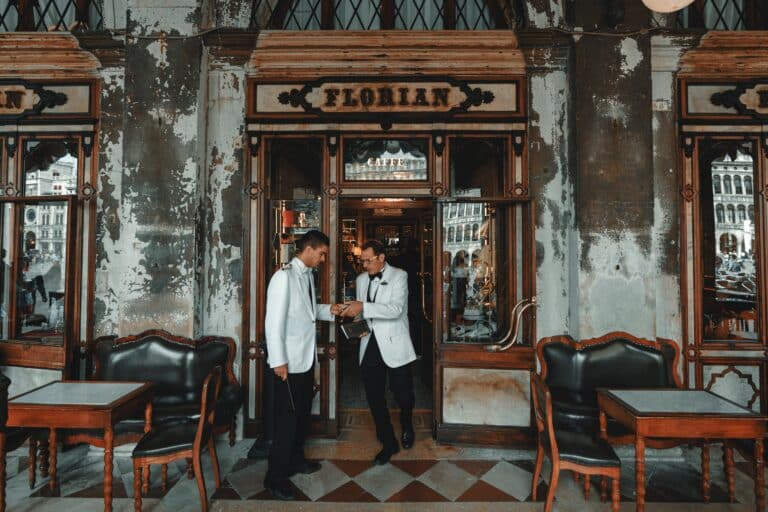
Where To Go For Coffee In Italy
Now that you’re ready, here are some of our favorite (and most famous) coffee shops in Italy that any coffee lover should not miss.
Rome: Tazza D’Oro or Sant’Eustachio
Locals love two famous options in Rome, just a few minutes walk from the Pantheon: Tazza d’Oro (the Golden cup) and Sant’Eustachio (pronounced, sahnt, eyoo-sta-key-oh). We prefer the coffee at Tazza d’oro but check them out when you visit Rome.
Florence: Caffè Gilli
Right in the heart of the city center, on the corner of Piazza della Repubblica, is the 300-year-old coffee bar, Caffè Gilli (pronounced “gee-lee”). There isn’t a Florentine in Florence who hasn’t had a coffee at this bar!
Venice: Caffè Florian
Located right in St. Mark’s Square, Caffè Florian is said to be the oldest coffee house in Europe, and it has been frequented by everyone from Proust to Casanova. Be warned, though, prices can be over 10 euros for a simple cappuccino.
Naples: Caffe Gambrinus
Naples is considered by many to be the home of the best coffee in Italy. And Caffe Gambrinus (gahm-bree-noos) does not disappoint. You can find it directly across from the busy Piazza del Plebiscito.
Insider tip: After all my years in Italy, especially after many trips down to the south in the hot summer, one of my favorite coffee drinks is “caffè leccese.” It’s simple, just almond milk, ice, and coffee, but it demands a skilled barista to get the proportions right. It is one of the most classic Puglia food or drink to try when you travel to the region, so be sure to order it in Lecce if you’re visiting Puglia on your next trip.
Get A Personalized Travel Itinerary
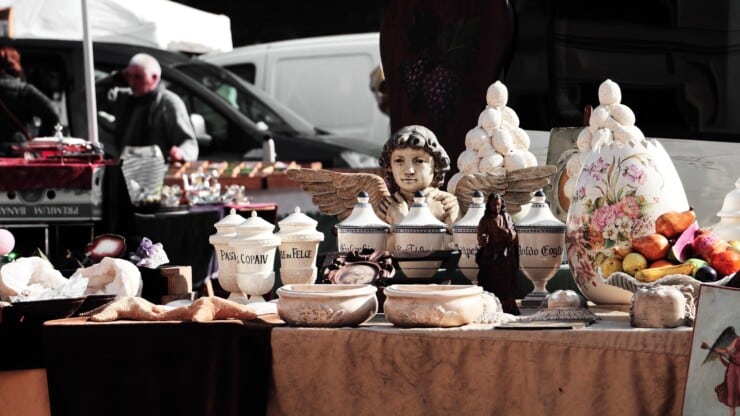
Tips For Shopping In Italy
Once you’re all fueled up from your coffee break, you’ll be all set to go shopping in Italy. From how to buy produce to the best shopping streets in the major cities, check out our more than 19 tips for shopping in Italy.
Have Us Plan Your Italy Trip
Did you know we’re also a boutique travel agency specializing in Italy travel planning? If you’re looking to plan one of the best trips to Italy, our Italy trip planner services are here to help you plan your perfect itinerary.
Photo Credit: Photo of coffee with newspaper by Elena.Katkova; barista pouring coffee Photo by Liam Martens on Unsplash; Caffe Florian Photo by Clay Banks on Unsplash